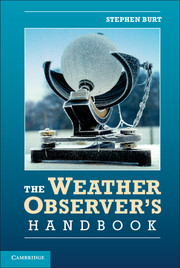Book contents
- Frontmatter
- Contents
- Acknowledgements
- Abbreviations, footnotes and references
- Part One The basics
- Part Two Measuring the weather
- Part Three Making the most of your observations
- Appendix 1 Metrology and meteorology: The basics of instrument theory
- Appendix 2 Useful functions
- Appendix 3 Unit conversions
- Appendix 4 Useful sources
- Index
- References
Appendix 1 - Metrology and meteorology: The basics of instrument theory
Published online by Cambridge University Press: 05 July 2012
- Frontmatter
- Contents
- Acknowledgements
- Abbreviations, footnotes and references
- Part One The basics
- Part Two Measuring the weather
- Part Three Making the most of your observations
- Appendix 1 Metrology and meteorology: The basics of instrument theory
- Appendix 2 Useful functions
- Appendix 3 Unit conversions
- Appendix 4 Useful sources
- Index
- References
Summary
Metrology is the science of instruments and their behaviour. Meteorology is the science of the atmosphere and its phenomena. The two are intimately related by far more than having all but two letters in common, for meteorology depends upon instrumentation to provide quantitative measurements of the state of the atmosphere at any time or over a period of time.
For most users of meteorological instruments it is certainly not essential to possess a detailed knowledge of the mathematical and physical principles behind the theory and design of any particular sensor, but it can be helpful to understand a few basic concepts and terms as they apply to both the sensors themselves and the output of measurement systems. A knowledge of how sensors react to the elements they measure, what the outputs are and how they are interpreted into useful forms, what errors or limitations there may be on those outputs, and how key sensor characteristics can be compared, all help to create a clearer understanding of the way any measurement system performs and its applicability to the application in hand.
This appendix provides a very simplified overview of some of the basics of measurement as applied to meteorological sensors. An excellent single-volume reference source on the subject is Meteorological measurement systems by Fred Brock and Scott J. Richardson, published by Oxford University Press in 2001; some of the following material has been adapted and summarized from this standard work. Readers who seek more detailed information beyond the necessarily brief topics outlined here are recommended to consult this volume.
- Type
- Chapter
- Information
- The Weather Observer's Handbook , pp. 409 - 415Publisher: Cambridge University PressPrint publication year: 2012



